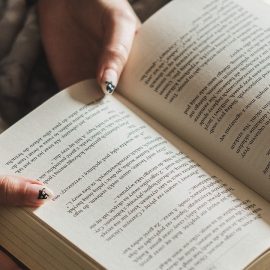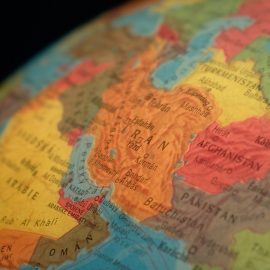
We’ve put together discussion questions for I Am Malala by Malala Yousafzai that you can use with a book club, a class at school, or a team at work. We include sample answers, book club activities that will help you get more out of what you’ve read, and recommendations for more reading if you like this book.
Table of Contents
Book Synopsis
I Am Malala is the memoir of Malala Yousafzai, a Pakistani activist who was shot by the Taliban when she was fifteen years old for advocating for girls’ education. The book chronicles her childhood in Pakistan’s Swat Valley, where she grew up in a family that valued education (her father ran a school and encouraged her activism). As the Taliban gained control of the region, they banned girls from attending school, prompting young Malala to speak out publicly about the importance of education. Her activism made her a target, culminating in the 2012 assassination attempt that left her critically wounded.
After receiving treatment in the United Kingdom, Malala recovered and continued her advocacy on a global scale, becoming the youngest-ever Nobel Prize laureate in 2014. The memoir interweaves her personal story with the history and politics of Pakistan, Taliban extremism, and the struggles facing women and girls seeking education in her homeland. It’s both an inspiring account of courage and resilience and a powerful call to action for universal education rights. The book ultimately tells the story of how one young woman’s voice became a symbol of peaceful resistance against oppression.
Read Shortform’s comprehensive guide to this book.
I Am Malala Discussion Questions & Sample Answers
Along with discussion questions for I Am Malala, we include sample answers you can use as prompts.
- What does the title “I Am Malala” suggest about identity and self-determination in the face of oppression?
- Sample answer: I think the title is really powerful because it’s such a simple declaration of existence and defiance. The Taliban tried to silence her (literally tried to destroy her), but she’s saying “I’m still here; I’m still me.” It reminds me of how important it is to claim your own identity, especially when others are trying to define you or make you disappear. She’s not just surviving—she’s insisting on being herself.
- How does Malala’s relationship with her father shape her activism and worldview?
- Sample answer: Her father was clearly her biggest influence and supporter. He ran a school and really believed in education for everyone, which was pretty radical in that context. What I found interesting was that he encouraged her to speak up and have opinions when many fathers in that culture would have done the opposite. He treated her like she mattered, like her voice was important, and I think that gave her the confidence to become who she became.
- What role does education play in the book beyond just learning to read and write?
- Sample answer: Education is presented as a transformative force—it’s not just about getting a job or learning facts. For Malala, it represents freedom, possibility, and power. The Taliban also understood that, which is why they were so threatened by it. When girls are educated, they can make their own choices, question authority, and change their circumstances. That’s why banning girls from school was about control.
- How does Malala portray the complexity of Pakistani culture and society?
- Sample answer: I appreciated that she didn’t paint Pakistan with one brush. She shows the beauty of her culture (the hospitality, the poetry, the family bonds), alongside the problems such as corruption and extremism. She makes it clear that the Taliban doesn’t represent all of Islam or all Pakistanis. There are people fighting for progress and people holding onto extremism, just like anywhere else. It felt honest and nuanced.
- What does the book reveal about the Taliban’s motivations and tactics?
- Sample answer: They used fear and twisted religion to control people. What struck me was how gradual it was; they didn’t just show up and take over. They slowly gained influence through radio broadcasts, making promises and then incrementally restricting freedoms. By the time people realized what was happening, speaking out became dangerous. They targeted education specifically because educated people are harder to manipulate.
- How did Malala’s brush with death change her perspective or mission?
- Sample answer: In some ways, it amplified what she was already doing, but it also gave her this huge platform she wouldn’t have had otherwise. I think the shooting made her even more determined because she felt like she’d been given a second chance. But there’s also this sense that she lost something—her home, her anonymity, her normal life. She couldn’t go back to Pakistan safely. So it’s bittersweet in a way.
- What does the book suggest about the power of individual voice versus group action?
- Sample answer: Malala’s individual voice became incredibly powerful, but she’s always clear that she’s not alone in this fight. There were other girls who wanted to go to school, other activists, and her father’s network. I think her story shows that sometimes one person’s courage can inspire a group to act, but also that individual voices need support systems and movements behind them to create real change.
- How does Malala balance her Islamic faith with her views on women’s rights?
- Sample answer: She makes a really important point that Islam doesn’t forbid girls’ education. She’s a practicing Muslim who prays and values her faith, but she interprets it in a way that supports equality and education. I think this is one of the most important aspects of the book because it challenges assumptions that you can’t be both religious and feminist.
- What role do women in Malala’s life play in shaping her story?
- Sample answer: Her mother is interesting because she’s more traditional and not educated herself, but she supports Malala completely. Then there are teachers, friends, and other women activists who show different ways of being strong. I wish we’d heard more from them, actually, but you can see that Malala was surrounded by women who were resilient in their own ways, even if they weren’t all activists.
- How does the book address the concept of home and displacement?
- Sample answer: There’s this real sadness about losing home. Even though Malala is safe in England and has opportunities there, she misses Pakistan deeply—the food, the landscape, her friends, just being home. You can build a new life, but that loss of home stays with you. She became this global figure—but at the cost of belonging to the place she loved.
- What does Malala’s story reveal about the intersection of gender, education, and poverty?
- Sample answer: In her region, poverty made families more vulnerable to extremist ideology, and girls were the first to lose access to education because they weren’t valued economically the same way boys were. Education becomes this cycle—without it, girls marry young, have limited opportunities, and their daughters face the same fate. Malala shows how gender inequality is reinforced by poverty and how education is the key to breaking that cycle.
- How does the book portray the role of media and public attention in activism?
- Sample answer: The media really amplified Malala’s voice—first through her BBC blog and then after the shooting when she became international news. But there’s a double edge to it. The attention helped her cause but also made her more of a target. And you have to wonder about all the other girls fighting for education who don’t get media attention. Malala herself seems aware of this privilege and responsibility.
- What does I Am Malala suggest about courage and fear?
- Sample answer: Malala admits to being afraid, which I found really humanizing. She wasn’t fearless; she was scared but spoke up anyway. That’s real courage. And, even after being shot, she kept going despite knowing the risks. It made me think about how we often wait to feel brave before acting, but courage is just acting despite the fear.
- How does Malala’s experience reflect broader issues of extremism and fundamentalism?
- Sample answer: Her story shows how extremism thrives in places where there’s instability, lack of education, and poverty. The Taliban filled a power vacuum and offered simple answers to complex problems. It’s not unique to Pakistan or Islam; we see similar patterns with different groups around the world. Education and economic opportunity seem to be the best defenses against extremism taking root.
- What’s the significance of Malala winning the Nobel Peace Prize as a teenager?
- Sample answer: It was historic and sent a powerful message that young people can be change-makers, not just future leaders. But I also wondered if it put too much pressure on her. She’s expected to be this perfect symbol, and she was just a kid. At the same time, giving the prize to someone so young for advocating for education made a statement about what the world should value. It elevated her platform tremendously.
- How does the book challenge perceptions of Muslim women?
- Sample answer: It definitely pushes back against the “helpless Muslim woman” stereotype. Malala is strong, opinionated, and advocates for herself while also being devoutly Muslim. She’s not waiting to be saved from the outside; she’s fighting from within her own culture and faith. I think some readers want to see Muslim women as victims, and Malala complicates that by being both vulnerable and incredibly powerful.
- What does Malala’s recovery process reveal about resilience and support systems?
- Sample answer: The medical care she received was incredible, but what really struck me was the emotional recovery. She had her family with her, people supporting her, a purpose to return to. That support system was crucial. It made me think about how resilience isn’t just individual strength; it’s about having people around you and having something meaningful to live for.
- How does I Am Malala address the tension between tradition and progress?
- Sample answer: Malala respects many traditions—she values her culture, her religion, hospitality norms—but she also advocates for change where tradition oppresses people, especially women. She doesn’t throw everything out; she’s selective. I think she shows that you can honor your heritage while also pushing it to evolve. It’s not all or nothing, tradition versus modernity. There’s a middle path.
- What responsibility do you think Malala feels toward other girls fighting for education?
- Sample answer: She seems to feel a huge responsibility to use her platform for others. She could have just lived quietly in England, but instead she started the Malala Fund and keeps advocating. I think surviving the attack made her feel obligated to speak for girls who don’t have her platform. But that’s also got to be exhausting—carrying that weight of representation at such a young age.
- What’s the most important message you took away from reading the book?
- Sample answer: For me, it was that education is the most powerful tool for changing your life and your society. It sounds simple, but the book really drove home why people fight so hard against it and why it’s worth fighting for. Also, that ordinary people—even kids—can make extraordinary differences if they’re willing to speak up. Malala was just a schoolgirl who decided her voice mattered, and look what happened.
Book Club Activities for This Book
Discussing I Am Malala can be just the beginning! Use these activities to get even more out of the book and create unforgettable experiences.
Activity #1: Education Access Mapping & Reflection
Create a visual comparison of education access across different contexts. Draw or design a chart that maps your own educational journey alongside Malala’s, noting key milestones, obstacles, and opportunities. Then research current global education statistics, particularly focusing on girls’ education in different regions. Identify three countries or communities where girls face significant barriers to education, and list the specific obstacles they encounter (poverty, cultural norms, conflict, distance to schools, etc.). Reflect in writing on what you’ve taken for granted about your own education, and identify one concrete action you could take to support educational access for others—whether that’s donating to organizations such as the Malala Fund, tutoring in your community, or advocating for educational equality.
Activity #2: Personal Courage Journal
Malala demonstrated immense courage by speaking out despite threats, but she also expressed fear and doubt. For one week, keep a “courage journal” where you reflect daily on moments requiring bravery in your own life. These don’t need to be dramatic; courage can mean having a difficult conversation, standing up for someone, trying something new, or speaking an unpopular truth. Each day, write about a situation where you felt afraid or uncertain, what you chose to do, and what happened as a result. At the week’s end, write a longer reflection comparing your experiences of fear and courage to Malala’s. Consider questions such as these:
- What makes something worth being brave for?
- How do we find courage when we’re afraid?
- What beliefs or support systems help us act courageously?
Activity #3: “Amplify Their Voices” Research Project
Malala’s story received worldwide attention, but countless other young activists are fighting for education, women’s rights, and justice without recognition. Research and create a presentation (written, visual, or multimedia) about three to five young activists from different countries who are working on issues related to education, women’s rights, or justice. For each activist, include their background, what they’re fighting for, obstacles they face, and how people can support their work. Consider activists from regions that receive less media coverage in news where you live. Conclude your project with a reflection on whose stories get told and amplified versus whose remain unheard—and what factors contribute to this disparity. Share your project with others to help amplify these voices.
If You Like I Am Malala
If you want to read more books like I Am Malala, check out these titles:
- Educated—This memoir by Tara Westover tells the story of a woman who grew up in a survivalist family in rural Idaho with no formal education, yet she eventually earned a PhD from Cambridge University. Like Malala’s story, this book explores the transformative power of education and the courage it takes to pursue learning when your community opposes it. While the contexts are vastly different—American religious fundamentalism versus Taliban extremism—both books examine how education can be seen as threatening to traditional power structures and how young women can fight for their right to learn despite family and community pressure. Westover’s journey of self-discovery through education will resonate with readers moved by Malala’s dedication to learning.
- The Breadwinner—This young adult novel by Deborah Ellis tells the story of eleven-year-old Parvana, a girl living in Taliban-controlled Afghanistan who disguises herself as a boy to support her family after her father is arrested. While fictional, the book provides insight into daily life under Taliban rule and the specific hardships faced by women and girls—themes central to Malala’s memoir. The story illustrates the resilience and resourcefulness of young people facing oppression, making it an excellent complement to Malala’s real-life account. Ellis’s novel helps readers (especially younger ones) understand the regional context and cultural realities that shaped Malala’s experiences.
- Half the Sky: Turning Oppression Into Opportunity for Women Worldwide—This book by Nicholas D. Kristof and Sheryl WuDunn examines gender-based oppression globally, sharing stories of women fighting against sex trafficking, maternal mortality, gender-based violence, and lack of education. Like I Am Malala, it combines personal narratives with broader social analysis, showing how individual courage can spark systemic change. The book provides context for understanding Malala’s activism within the larger global women’s rights movement and profiles other remarkable women advocates from various countries. Readers inspired by Malala’s story will find numerous other stories of courage and resilience, along with actionable information about how to support women’s rights and education worldwide.
Discuss More Books
Shortform has discussion questions for scores of books. Take a look!






